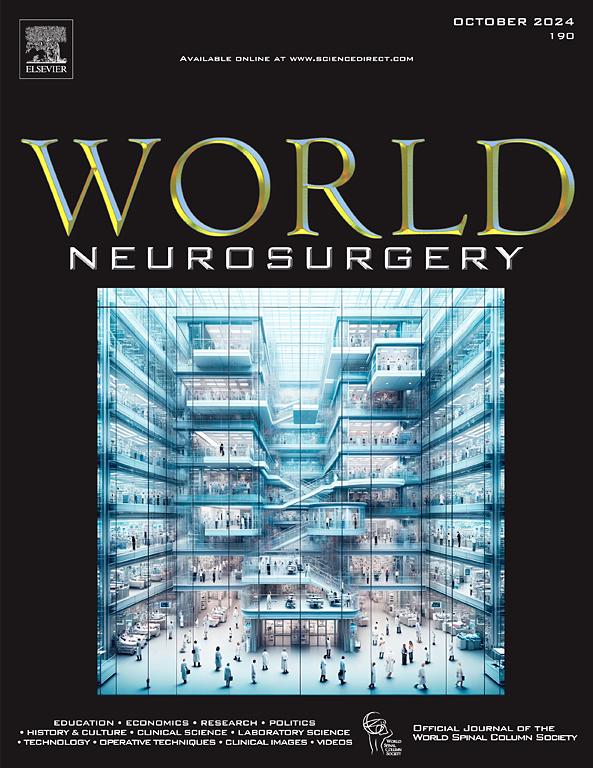Comparison of Lumbar Spinous Process-Splitting Laminectomy versus Conventional Laminectomy for Lumbar Spinal Stenosis: A Systematic Review and Meta-Analysis
IF 1.9
4区 医学
Q3 CLINICAL NEUROLOGY
引用次数: 0
Abstract
Background
This meta-analysis compared the clinical efficacy of lumbar spinous process-splitting laminectomy (LSPSL) and conventional laminectomy (CL) for lumbar spinal stenosis (LSS) for treating lumbar stenosis.
Methods
We conducted a comprehensive literature review on PubMed, Embase, Cochrane library, and CNKI until March 2024 to identify studies that compared LSPSL with CL for the treatment of LSS. This meta-analysis was carried out with the use of RevMan 5.3 software.
Results
Eight studies comprising 801 patients (431 for LSPSL, 370 for CL) were included in this meta-analysis. Comparable outcomes in terms of visual analog scale, Japanese Orthopedic Association scores, Japanese Orthopedic Association recovery rate, Oswestry disability index were noted after surgery. No significant differences were observed in operative time, intraoperative blood loss, complication rates, and re-operation rates. However, LSPSL presented a significantly lower muscular dystrophy rate than CL (weighted mean difference: −16.61, 95% confidence interval: [−21.60, −11.64], P < 0.00001, I2 = 0%;).
Conclusions
Based on this meta-analysis, both LSPSL and CL can provide a comparably clinical outcomes and complication rates for the treatment of LSS. However, LSPSL demonstrated a superior advantage in terms of muscular dystrophy rate.
腰椎棘突劈裂椎板切除术与传统椎板切除术治疗腰椎管狭窄的比较:一项系统回顾和荟萃分析。
背景:这项荟萃分析比较了腰椎棘突分离椎板切除术(LSPSL)和传统椎板切除术(CL)治疗腰椎管狭窄症(LSS)的临床疗效:我们在PubMed、Embase、Cochrane图书馆和CNKI上对截至2024年3月的文献进行了全面回顾,以确定比较LSPSL和CL治疗腰椎管狭窄症的研究。荟萃分析使用 RevMan 5.3 软件进行:本次荟萃分析共纳入了八项研究,包括 801 名患者(431 名患者接受了 LSPSL 治疗,370 名患者接受了 CL 治疗)。术后在视觉模拟量表(VAS)、日本骨科协会评分(JOA)、JOA恢复率、Oswestry残疾指数(ODI)等方面的结果具有可比性。在手术时间、术中失血量、并发症发生率和再次手术率方面未发现明显差异。然而,LSPSL的肌肉萎缩率明显低于CL(WMD:-16.61,95% CI:[-21.60, -11.64],P2= 0%;):根据这项荟萃分析,LSPSL 和 CL 治疗 LSS 的临床疗效和并发症发生率相当。然而,LSPSL 在肌肉萎缩率方面更具优势。
本文章由计算机程序翻译,如有差异,请以英文原文为准。
求助全文
约1分钟内获得全文
求助全文
来源期刊

World neurosurgery
CLINICAL NEUROLOGY-SURGERY
CiteScore
3.90
自引率
15.00%
发文量
1765
审稿时长
47 days
期刊介绍:
World Neurosurgery has an open access mirror journal World Neurosurgery: X, sharing the same aims and scope, editorial team, submission system and rigorous peer review.
The journal''s mission is to:
-To provide a first-class international forum and a 2-way conduit for dialogue that is relevant to neurosurgeons and providers who care for neurosurgery patients. The categories of the exchanged information include clinical and basic science, as well as global information that provide social, political, educational, economic, cultural or societal insights and knowledge that are of significance and relevance to worldwide neurosurgery patient care.
-To act as a primary intellectual catalyst for the stimulation of creativity, the creation of new knowledge, and the enhancement of quality neurosurgical care worldwide.
-To provide a forum for communication that enriches the lives of all neurosurgeons and their colleagues; and, in so doing, enriches the lives of their patients.
Topics to be addressed in World Neurosurgery include: EDUCATION, ECONOMICS, RESEARCH, POLITICS, HISTORY, CULTURE, CLINICAL SCIENCE, LABORATORY SCIENCE, TECHNOLOGY, OPERATIVE TECHNIQUES, CLINICAL IMAGES, VIDEOS
 求助内容:
求助内容: 应助结果提醒方式:
应助结果提醒方式:


